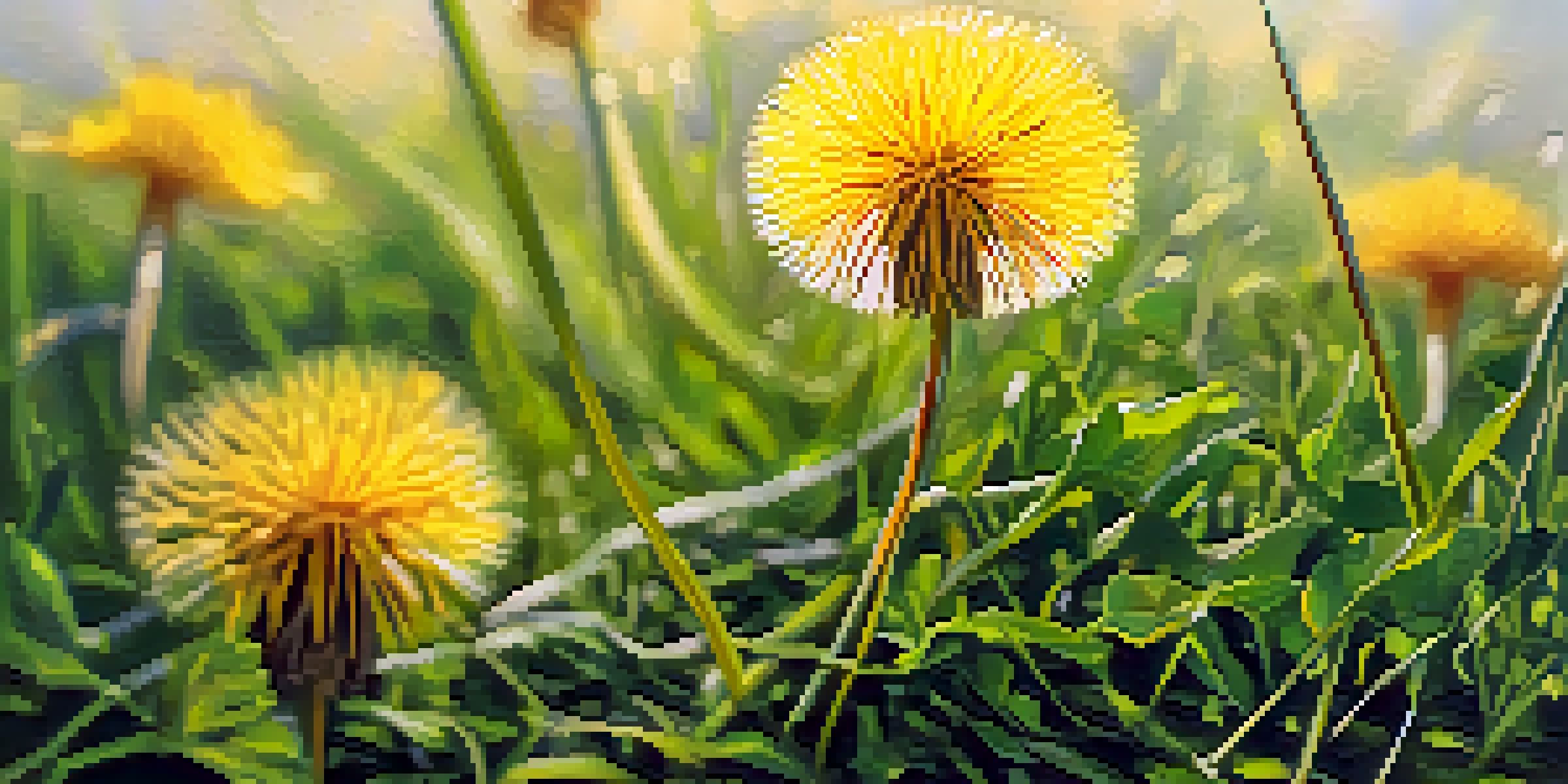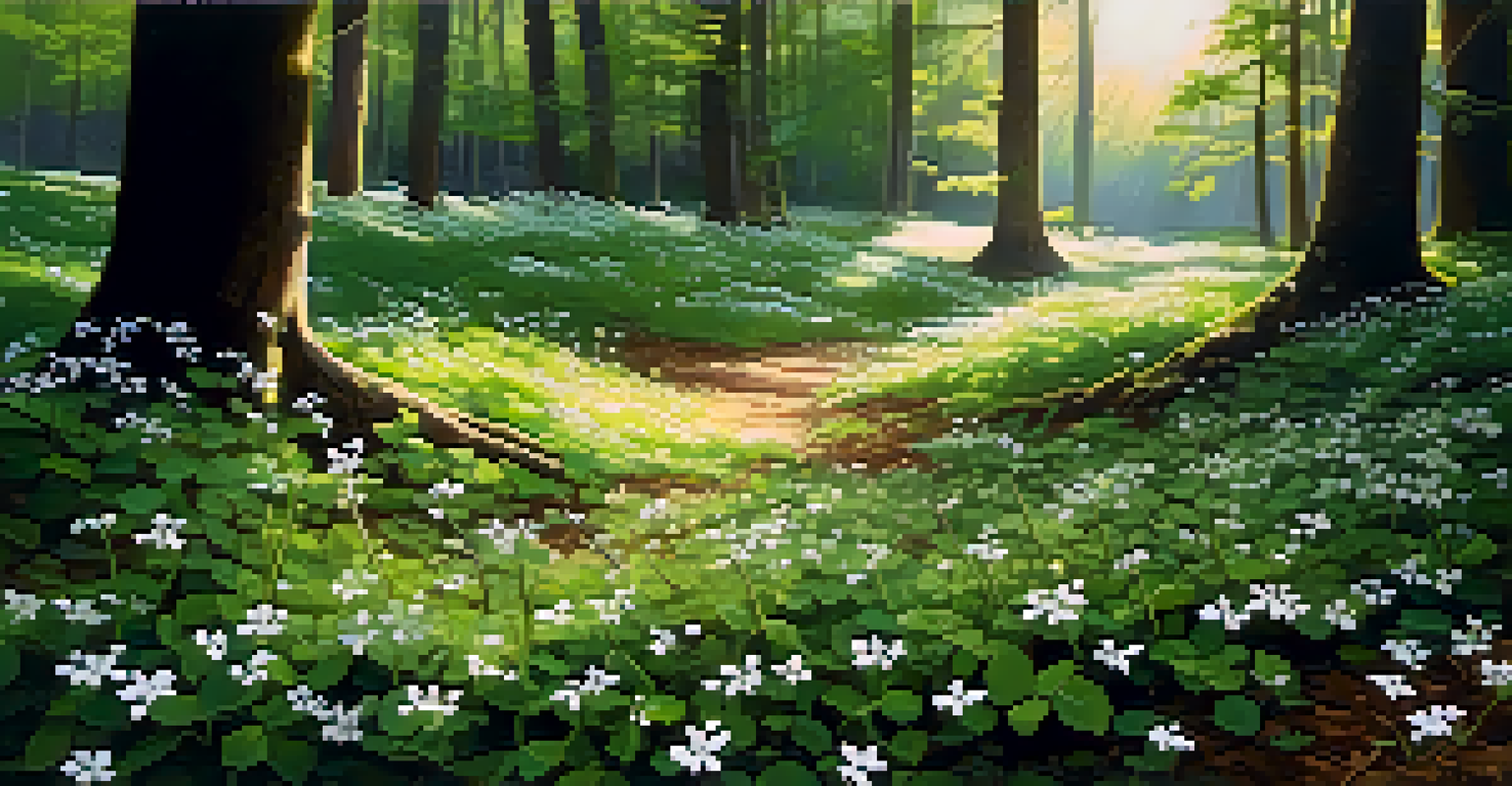Top 10 Edible Plants to Forage in Your Local Area

Introduction to Foraging: A Tasty Adventure Awaits
Foraging is not just a fun outdoor activity; it connects you with nature and offers fresh, tasty options for your table. Imagine walking through a forest or park and discovering edible plants that are often overlooked. With a little knowledge and care, you can safely gather these natural goodies to enhance your meals.
Foraging is a great way to reconnect with nature and the food you eat.
However, it's essential to familiarize yourself with the plants in your area, as some may look alike but can be inedible or even toxic. Start by educating yourself about the local flora through books, apps, or foraging classes. This knowledge will empower you to explore your surroundings and enjoy the bounty of nature.
As we dive into the top 10 edible plants you can forage, remember to respect the environment. Always forage responsibly: take only what you need, leave some for wildlife, and ensure you're not damaging the ecosystem. Ready to embark on this culinary journey?
1. Dandelion: The Overlooked Superfood
Dandelions are often seen as pesky weeds, but they are a powerhouse of nutrition. Every part of the plant is edible, from the vibrant yellow flowers to the bitter leaves and even the roots. You can enjoy dandelion greens in salads or sauté them for a delicious side dish.

Rich in vitamins A, C, and K, dandelions also provide antioxidants that can boost your health. Plus, their slightly bitter flavor adds a unique twist to your culinary creations. So next time you see dandelions popping up in your yard, consider them as a valuable addition to your kitchen.
Foraging Connects You with Nature
Engaging in foraging allows you to explore your surroundings while enhancing your meals with fresh, nutritious ingredients.
Just remember to harvest them from areas free of pesticides and pollutants. A little care in foraging can lead to a delightful and nutritious addition to your meals.
2. Wild Garlic: Nature's Flavor Booster
Wild garlic is a fragrant herb that brings a burst of flavor to any dish. Found in woodlands and shaded areas, its broad leaves and white flowers are easy to identify. The smell of garlic is a telltale sign you’re close to this delicious plant.
The greatest gift of the garden is the restoration of the five senses.
You can use wild garlic in a variety of dishes, from pesto to soups, or simply toss it in salads for an aromatic kick. Its flavor is milder than cultivated garlic, making it a perfect choice for those who prefer a subtler taste. Plus, it’s packed with nutrients and has antibacterial properties.
When foraging for wild garlic, make sure you're confident in your identification skills, as some plants may look similar. Enjoy the thrill of finding this culinary treasure on your next nature walk!
3. Chickweed: A Nutritious Green Delight
Chickweed is a tender, leafy green that often grows in gardens and disturbed soils. With its small white flowers and delicate leaves, it’s not only easy to identify but also incredibly nutritious. Chickweed is rich in vitamins and minerals, making it an excellent addition to your diet.
Its mild flavor lends itself well to salads, sandwiches, or as a garnish for soups. You can even blend it into smoothies for an extra health boost. Plus, it’s low in calories, making it a guilt-free way to add volume and nutrients to your meals.
Identify Edible Plants Safely
Familiarizing yourself with local flora is crucial for safe foraging, as some plants can be toxic or inedible.
When foraging chickweed, look for lush patches and avoid areas that may have been treated with chemicals. Embrace this little green gem and enjoy its benefits!
4. Purslane: The Succulent Superfood
Purslane is a succulent plant that often grows in gardens and along roadsides. Its fleshy leaves and stems are not only edible but also packed with omega-3 fatty acids and antioxidants. With a slightly tangy flavor, purslane can add a refreshing twist to salads or be used in stir-fries.
This plant thrives in sunny areas and is often considered a weed, making it easy to find. Just be cautious when foraging; ensure you’re picking from clean areas, free from pollution or chemicals. Its unique texture and flavor can elevate your dishes, making it a favorite among foragers.
Incorporating purslane into your meals can be a delightful way to explore new flavors while boosting your health. Don't overlook this vibrant plant on your foraging adventures!
5. Lamb's Quarters: Nature's Leafy Green
Lamb's quarters, often considered a weed, are actually a highly nutritious leafy green. With a mild flavor similar to spinach, they can be used in a variety of dishes, from salads to soups. The leaves are rich in vitamins A and C, calcium, and iron, making them a fantastic addition to your diet.
This plant thrives in disturbed soils, making it common in gardens and fields. When harvesting, look for young, tender leaves for the best flavor and texture. The best part? Lamb's quarters are typically free from pests, so they often don’t require washing.
Forage Responsibly for Sustainability
Practicing responsible foraging ensures the health of ecosystems and availability of edible plants for future generations.
By foraging for lamb's quarters, you’re not only enjoying a delicious green but also reducing waste by utilizing a plant that many consider unwanted. Embrace this culinary adventure as you gather nature's bounty!
6. Nettles: The Surprisingly Delicious Stinging Plant
Nettles might be known for their sting, but once cooked, they transform into a delicious and nutritious treat. Found in damp, shaded areas, these leafy greens are packed with vitamins A and C, iron, and protein. Cooking them neutralizes their sting, making them safe and tasty to eat.
You can use nettles in soups, teas, or as a spinach substitute in various dishes. Their earthy flavor adds depth to meals, and they’re often used in traditional recipes across many cultures. Plus, they’re a great source of sustainable nutrition.

When foraging for nettles, wear gloves to protect yourself from their sting, and always ensure you’re harvesting from clean areas. Embrace the challenge and enjoy the rewards of this unique edible plant!
7. Wood Sorrel: A Tangy Treat from the Forest
Wood sorrel is a delightful plant with heart-shaped leaves and tiny yellow flowers. Its zesty, lemony flavor makes it a refreshing addition to salads, sauces, or even as a garnish for dishes. Rich in vitamin C, wood sorrel offers a tasty way to enhance your meals while boosting your health.
Often found in shady areas of forests or gardens, wood sorrel is easily identifiable by its clover-like leaves. When foraging, be mindful not to take too much from one area to ensure its continued growth. Its unique flavor can add a surprising element to your culinary creations.
Incorporating wood sorrel into your meals is a simple way to enjoy the flavors of nature. So next time you're out exploring, keep an eye out for this tart little treat!
8. Conclusion: Embracing Nature's Edible Gifts
Foraging for edible plants is a rewarding way to connect with nature and enhance your culinary repertoire. From the vibrant dandelion to the tangy wood sorrel, each plant offers unique flavors and nutritional benefits. By learning to identify these local edibles, you can enjoy the thrill of gathering your own food.
As you venture into the outdoors, remember to forage responsibly and sustainably. Respect the environment by taking only what you need and leaving some for wildlife and other foragers. This mindful approach ensures that these plants can be enjoyed for generations to come.
So gear up, grab a basket, and head out for your foraging adventure! The world around you is filled with delicious treasures just waiting to be discovered.